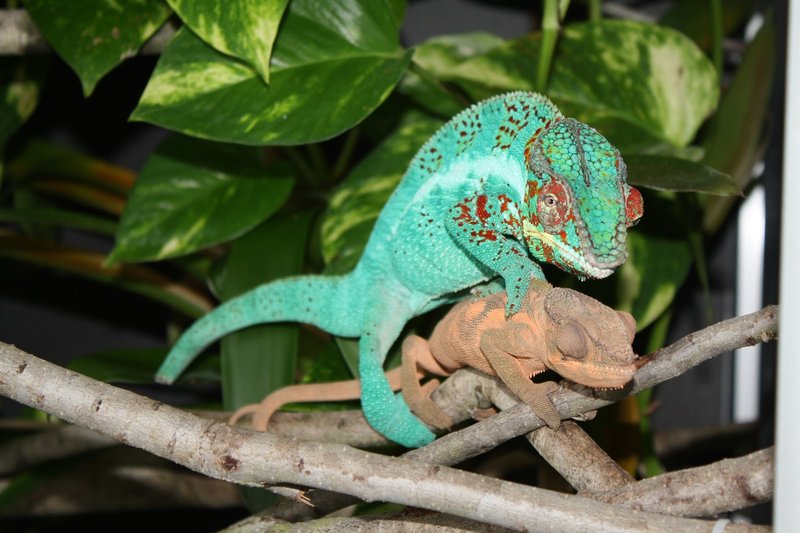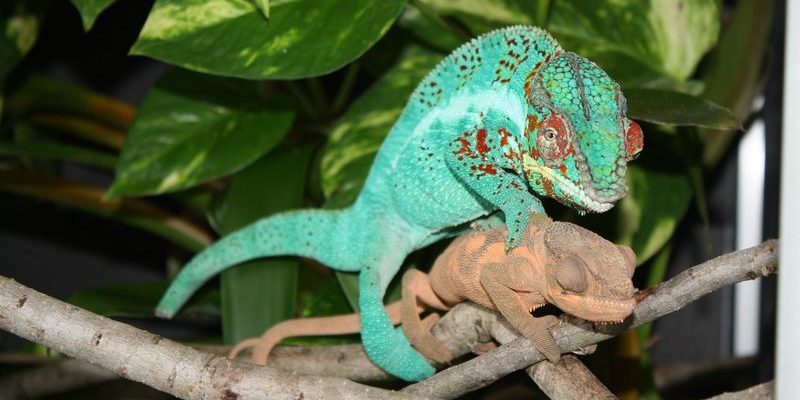
Understanding the breeding and reproductive behavior of Panther Chameleons can help you appreciate these creatures even more. Whether you’re a seasoned reptile enthusiast or just a curious observer, there’s a lot to learn about how these colorful critters propagate. It’s like peering into a hidden world, revealing the complexities of life that we often overlook.
Understanding Panther Chameleon Mating Habits
First off, let’s get a sense of how Panther Chameleons find their mates. Mating season usually starts in spring and can stretch into early summer. During this time, males become more vibrant, showcasing intense colors to attract females. Think of it as a flashy advertisement for their fitness—a way to catch the eye of a potential partner.
Here’s the thing: it’s not just looks that matter. Male Panther Chameleons are also known for their behavioral displays. They might puff up their bodies, bob their heads, and even perform a little dance. This courtship ritual is crucial; it signals to females that they are healthy and ready to mate. If a female is interested, she might respond with her own signals, usually involving subtle movements and color changes.
Defining who gets to mate isn’t always clear-cut. In the wild, larger males often dominate smaller ones, leading to more competition. However, females also have a say in this game. They can choose to accept or reject advances, ensuring that they select the strongest and most suitable mates. This selective process helps improve the overall health of the population.
The Breeding Process: From Courtship to Copulation
Once a female Panther Chameleon has selected a male, the breeding process begins. Copulation is quite straightforward but can be intense to witness. The male will grab the female around her waist with his jaws, securing her in place. While this might sound aggressive, it’s a common practice in the reptile world and isn’t harmful.
After copulation, the female will lay her eggs a few weeks later. Panther Chameleons typically lay around 20 to 30 eggs, but this number can vary. She’ll dig a hole in the ground, often in loose, moist soil, to create a safe environment for her eggs. It’s a bit like setting up a nursery before the little ones arrive—she’s ensuring they have the best chance of survival.
The eggs take about five to seven months to incubate, depending on environmental conditions. During this time, the female doesn’t need to stay with the eggs, as they are protected by the soil. However, she does have to be cautious of predators, as many animals enjoy snacking on chameleon eggs.
Incubation and Hatching: The Journey of the Hatchlings
After several months of waiting, it’s time for the eggs to hatch. This is an exciting moment for chameleon enthusiasts and a critical event for the species. When the hatchlings break free from their eggs, they’re remarkably independent. They don’t rely on their mother for care, which is quite different from many other animals.
Once they emerge, baby Panther Chameleons are miniature versions of adults. They’re usually around 3 to 4 inches long and can instantly adapt to their surroundings. The hatchlings will need to fend for themselves right away, finding food and shelter in their environment. This early independence is vital, as only a small percentage of them will survive to adulthood.
Survival is tough. The young chameleons face threats from predators and environmental challenges. As they grow, they’ll rely on their camouflage to blend in with their surroundings, which is crucial for avoiding dangers. This instinctive behavior highlights the importance of survival skills learned from their very first moments.
Environmental Factors Influencing Breeding
The environment plays a significant role in the breeding habits of Panther Chameleons. They are typically found in Madagascar, where humidity, temperature, and even seasonality impact their reproductive cycles. For example, if the rainy season is particularly strong, it can lead to higher moisture levels in the soil, which might encourage females to lay more eggs.
Temperature is another critical factor in this process. Panther Chameleons thrive in warm conditions, and their breeding behavior can be significantly influenced by the climate. If temperatures drop too low, mating may be delayed or even prevented. It’s a delicate balance that these creatures must navigate to ensure successful reproduction.
Moreover, habitat destruction poses a threat to their breeding patterns. As forests are cleared for agriculture or urban development, Panther Chameleons lose their nesting sites. This loss can lead to a decline in their population, making conservation efforts essential for preserving their habitats.
Parental Care and Offspring Survival
Unlike many mammals, Panther Chameleons exhibit minimal parental care once the eggs are laid. The female’s job is largely done after ensuring the eggs are laid in a safe spot. This lack of care might seem alarming, but it’s a common strategy for many reptiles. It allows parents to conserve energy for future breeding cycles.
After the hatchlings emerge, they enter a world filled with challenges that demand quick adaptation. This period of independence is crucial, as they must learn to seek out food, avoid predators, and establish their territory. This self-sufficiency helps strengthen the species by ensuring that only the strongest hatchlings survive to adulthood.
In a sense, the survival of these chameleons hinges on their ability to thrive without parental guidance. It’s an evolutionary strategy that has worked well for them over thousands of years. However, it also emphasizes the importance of a healthy environment—one where young chameleons can find food and shelter without undue threats.
Challenges Faced in Breeding and Conservation
Despite their resilience, Panther Chameleons face numerous challenges in their quest to breed and survive. Habitat destruction is one of the most pressing issues, as deforestation and urban development destroy their natural homes. This makes it harder for them to find safe nesting sites and can severely impact their populations.
Additionally, climate change is affecting the delicate balance they depend on for successful breeding. Rising temperatures and altered rainfall patterns can disrupt their breeding cycles, leading to reduced reproduction rates. As conditions become less predictable, the survival of Panther Chameleons becomes increasingly vulnerable.
Conservation efforts are vital in addressing these challenges. By protecting their habitats and understanding their needs, we can help ensure that these beautiful creatures continue to thrive. Supporting local conservation programs and spreading awareness about these chameleons is a step in the right direction.
The Importance of Studying Panther Chameleons
Studying the breeding and reproductive behavior of Panther Chameleons offers invaluable insights into their ecological roles. Understanding their mating habits, egg-laying practices, and hatchling survival rates not only promotes conservation efforts but also enriches our knowledge of reptile behavior as a whole.
By observing these creatures, scientists can learn about the broader implications of habitat health, climate adaptation, and species survival. It’s like holding a mirror to our own interactions with nature, reminding us of the delicate balance that sustains life on our planet.
So, the next time you encounter a Panther Chameleon, take a moment to appreciate the complex web of behaviors that leads to the continuation of their species. It’s a reminder of the beauty and intricacy of nature—and how vital it is to protect it.
In closing, the breeding and reproductive behavior of the Panther Chameleon is not just a fascinating topic for animal lovers; it’s a crucial piece of the puzzle in understanding biodiversity. By learning more about these amazing lizards, we can help ensure their survival for generations to come.

